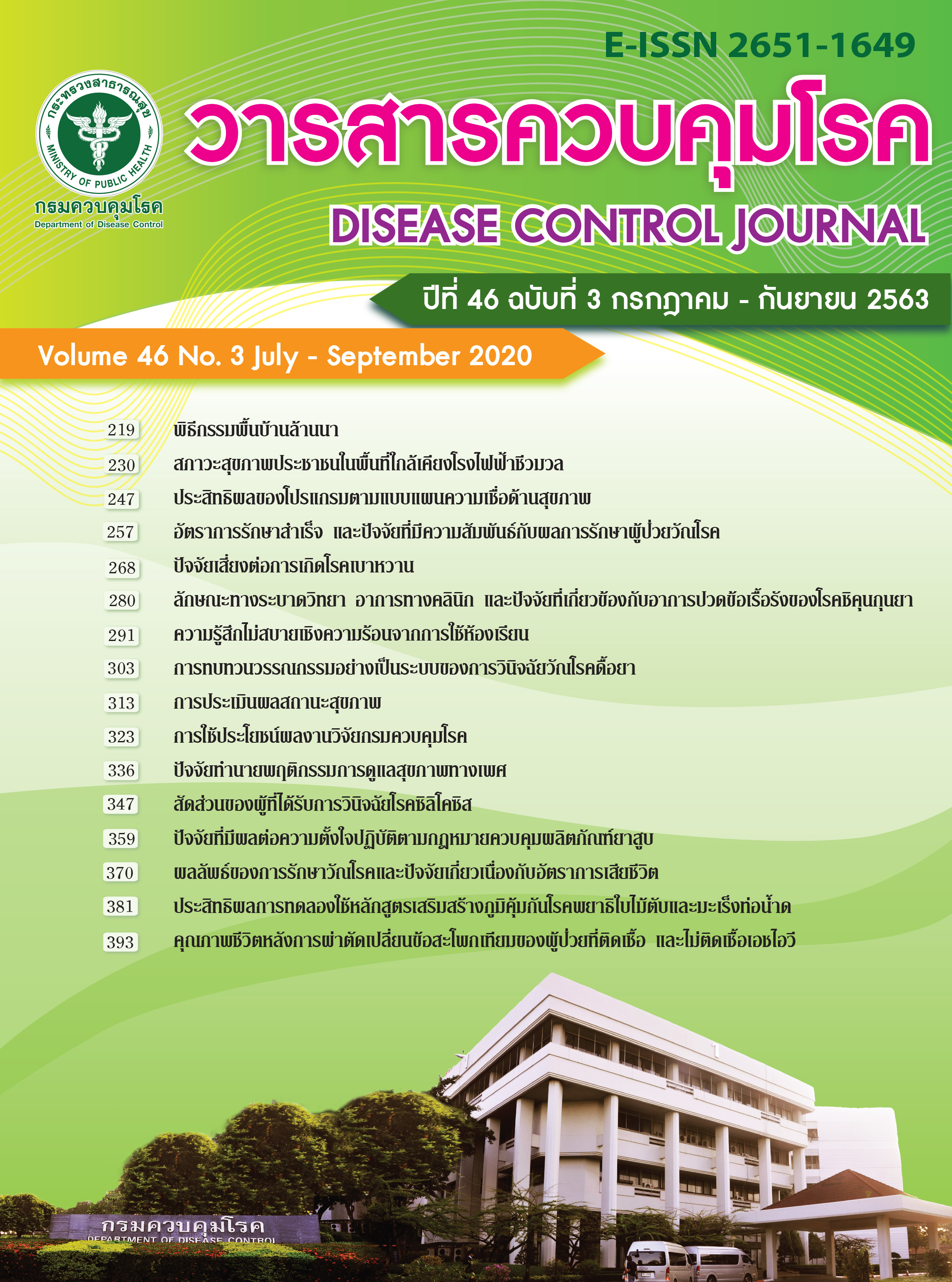Proportion of silicosis among workers with abnormal chest radiographs obtained from Nakhon Ratchasima silicosis surveillance system
DOI:
https://doi.org/10.14456/dcj.2020.33Keywords:
silicosis, silica dust, silica, surveillanceAbstract
Data from the occupational disease surveillance report revealed that the silicosis cases has increased slightly and the largest number of cases were found in Nakhon Ratchasima province. The aims of this study were (1) to assess the proportion of silicosis among workers having abnormal chest radiographs from silicosis surveillance system in Nakhon Ratchasima Province and (2) to assess general information and work characteristics of the workers who met silicosis criteria. The study design was descriptive study. The study population obtained from secondary data of Nakhon Ratchasima silicosis surveillance system from 2016 to 2018 which accounted for 105 workers from a total of 930 workers. The data collection tool was developed, as a record form, composed of general characteristics, job characteristics, and chest radiograph reports read by the NIOSH B-reader. The data were analyzed by descriptive statistics: proportion, median, interquartile range, and 95% confidence interval. The results revealed that 64.8% (68/105) of the workers included were male. The proportion of silicosis cases was 58.1% (61/105). Most of the cases categorized as being exposed to a high level of silica dust were 59.0% (36/61); among those, 61.1% (22/36) were exposed to silica dust for a period of 5-10 years. Additionally, all cases exposed to a low level of silica dust reported more than 10-year exposure. In conclusion, workers having abnormal lung parenchymal from the surveillance system revealed silicosis as high as 58.1%. Therefore, it is necessary to reduce the level of exposure to silica dust as well as to minimize the exposure duration.
Downloads
References
Bang KM, Attfield MD, Wood JM, Syamlal G. National trends in silicosis mortality in the United States, 1981-2004. Am J Ind Med 2008;51:633–9.
Fedotov IA, Eijkemans GJM. The ILO/WHO global programme for the elimination of silicosis (GPES). GOHNET Newsl 2007;12:1–2.
Chanvirat K, Chaiear N, Choosong T. Determinants of respirable crystalline silica exposure among sand-stone workers. Am J Public Health Res 2018;6:44–50.
Hnizdo E, Vallyathan V. Chronic obstructive pulmonary disease due to occupational exposure to silica dust: a review of epidemiological and pathological evidence. Occup Environ Med 2003;60:237–43.
Occupational Safety and Health Administration. Preliminary quantitative risk assessment. In: Occupational exposure to respirable crystalline silica—review of health effects literature and preliminary quantitative risk assessment. Washington, DC: OSHA; 2010.
Schulte PA, Rice FL, Key-Schwartz RJ, Bartley DL, Baron PA, Schlecht PC, et al. Human health effects. In: NIOSH hazard review: Health effects of occupational exposure to respirable crystalline silica. Cincinnati, OH: National Institute of Occupational Safety and Health; 2002. p. 21–79.
Adverse effects of crystalline silica exposure. American Thoracic Society Committee of the Scientific Assembly on Environmental and Occupational Health. Am J Respir Crit Care Med 1997;155:761–8.
Bureau of Occupational and Environmental Diseases. Occupational and Environmental diseases. In: Annual report 2018. Nonthaburi: Bureau of Occupational and Environmental Diseases; 2018. p. 21–40. (in Thai)
Silanun K, Chaiear N, Rechaipichitkul W. Prevalence of silicosis in stone carving workers being exposed to inorganic dust at Sikhiu district Nakhonratchasima province, Thailand; preliminary results. J Med Assoc Thai 2017;100:598–602.
Ramakul K. Epidermiological Review of Silicosis in Thailand. Dis Control Thai 2008;34:109–17. (in Thai)
Simarugumpai U, Pimda P. Case series of silicosis in workers who have occupational exposure to silica. Data collection from health surveillance system for silica, Nakhon Ratchasima province. Dis Prev Control 9th Nakhon Ratchasima J 2018;23:46-54. (in Thai)
Benjawung Y, Jungprasert W, editors. Occupational respiratory diseases. In: Diagnostic criteria of occupational diseases commemorative edition on the auspicious occasion of His Majesty the King’s 80th birthday Anniversary 5 December 2007. Bangkok: Social Security Office; 2007. p. 263–96. (in Thai)
Lee HS, Phoon WH, Ng TP. Radiological progression and its predictive risk factors in silicosis. Occup Environ Med 2001;58:467–71.
Leung CC, Yu ITS, Chen W. Silicosis. Lancet 2012;379:2008–18.
Balmes JR. Occupational lung diseases. In: LaDou J, editor. Current occupational and environmental medicine. 5th ed. New York: McGraw-Hill Medical; 2014. p. 362–85.
Barboza CEG, Winter DH, Seiscento M, Santos U de P, Terra Filho M. Tuberculosis and silicosis: epidemiology, diagnosis and chemoprophylaxis. J Bras Pneumol 2008;34:959–66.
Petsonk EL, Parker JE. Coal workers’ lung disease and silicosis. In: Fishman A, Elias J, Fishman J, Grippi M, Senior R, Pack A, editors. Fishman’s pulmonary diseases and disorders. Vol 1. 4th ed. New York: McGraw-Hill Education; 2008. p. 967–80.
Banks DE. Health effects of silica and coal dust exposures. In: Schwarz MI, King TE, editors. Interstitial lung disease. 5th ed. Shelton, CT: People’s Medical Pub. House; 2011. p. 499–542.
Krisorn P, Chaiear N, Subhannachart P, Dumavibhat N, Tungsagunwattana S. Sensitivity and specificity of occupational health doctors in reading pneumoconiosis radiographs. Am J Public Health 2018;6:106–10.
Yingratanasuk T, Seixas N, Barnhart S, Brodkin D. Respiratory health and silica exposure of stone carvers in Thailand. Int J Occup Environ Health 2002;8:301–8.
Churchyard GJ, Ehrlich R, teWaterNaude JM, Pemba L, Dekker K, Vermeijs M, et al. Silicosis prevalence and exposure-response relations in South African goldminers. Occup Environ Med 2004;61:811–6.
Dumavibhat N, Matsui T, Hoshino E, Rattanasiri S, Muntham D, Hirota R, et al. Radiographic progression of silicosis among Japanese tunnel workers in Kochi. J Occup Health 2013;55:142–8.
Wegman DH. The potential impact of epidemiology on the prevention of occupational disease. Am J Public Health 1992;82:944–54.
Downloads
Published
How to Cite
Issue
Section
License
Articles published in the Disease Control Journal are considered as academic work, research or analysis of the personal opinion of the authors, not the opinion of the Thailand Department of Disease Control or editorial team. The authors must be responsible for their articles.






